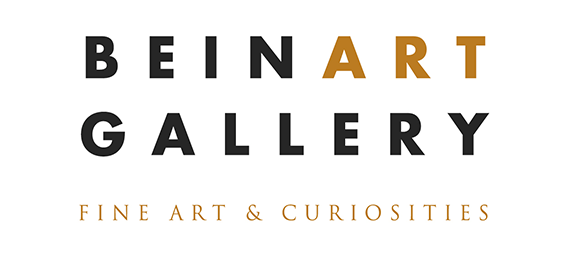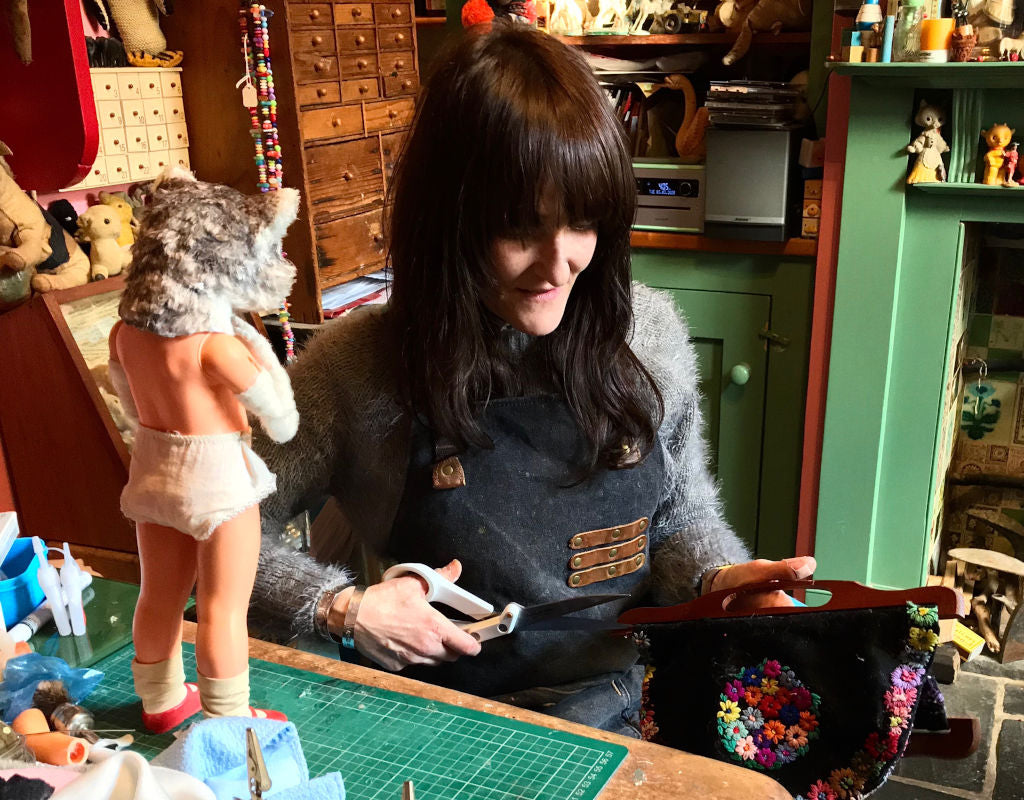
The best way to categorise both the work of Annie Montgomerie and the buzz which surrounds it is “unique”. Each painstakingly rendered sculpture is different to those that preceded it, owing not only to the one off nature of the vintage materials and trinkets that adorn them, but to the unique personality of each dirty-kneed, filthy-sleeved, anthropomorphic animal-child she brings into the world.
The U.K. based artist’s work has amassed an enormous following of devoted fans world-wide who are drawn in by emotive and nostalgic elements of her works, and let’s not lie, by just how damn cute they are. Her passionate collectors maintain an energy rivalling that of a pop culture fandom, snapping up every available artwork in the blink of an eye and always wanting more.
Having recently released her first book documenting her work and about to open a show at Beinart Gallery, we caught up with Annie to find out a bit more about the woman behind the sculptures and how her widely admired artworks came into being.
“When I first started my work some people would say “Oh, that’s scary and freaky, human bodies with animal heads.” But to me it seemed magical” – Annie Montgomerie

Pieces from Annie Montgomerie's solo show, Railing Latchers, at Beinart Gallery in 2021
Indigo Rawson-Smith: Your sculptures are steeped in childhood nostalgia and elements of school days from an era long past. You personally attended a convent school which you’ve said had quite an impact on you. What kind of memories do you have of your time there? How do you think those times influence and show up in your work?
Annie Montgomerie: Yes, I want my work to feel nostalgic, maybe not so much in a rose tinted way but a reflection of all the emotions you might feel as a child.
I went to a convent school after a series of unfortunate events in state school. I was bullied for being small but the final straw was when I was smacked by a teacher for poking my tongue out at one of the bullies in class.
Convent school was very strict religiously but I was sort of happier there. I was a bit of a rebel though and ended up in Mother Superior’s office a couple of times, usually over wearing makeup or writing band names on my school bag, hardly a crime but at the time it seemed very serious.
Before I hit my teens I did feel inadequate and lost most of the time and this is what I tap into with my anthropomorphic figures.

Dordla - Textiles and mixed media for Annie Montgomerie's solo show, Railing Latchers, at Beinart Gallery in 2021.
IRS: There’s a sense of idyllic, story book “Britishness”, the simple-ness and whimsy of a different era, which permeates your work, akin to the character of childhood favourites such as Peter Rabbit, The Wind in the Willows and Alice in Wonderland, which have endured for generations after generation. Do you identify with this at all? And do you think that the lasting and nostalgic appeal of these themes is part of the reason why so many people worldwide have become so attached to your work?
AM: When I was little my favourite books were Dick Bruna (author of the Miffy series) books, I loved the simple bold colours and the cute characters. My favourite tv shows were The Magic Roundabout, Mr Men, Pipkins, Bagpuss and The Clangers. It’s funny that when I first started my work some people would say “Oh, that’s scary and freaky, human bodies with animal heads”, but to me it seemed magical and quite natural as all the most popular stories and programs for children in my younger years were all anthropomorphic animals including Beatrix Potter stories, 'Rupert The Bear' and so on.
When I post pictures of my latest work on social media I get lots of comments like “ that reminds me of a time when”. Often it’s the clothes my pieces wear that take people back, it’s definitely something I feel when I see certain fabrics or wool clothes, jewellery or buttons and so on. That’s why I spend hours trawling flea markets and car boot sales to find just the right media for my work.

Beatty in Her Birthday Best - Textiles, vintage clothes, epoxy clay, plastic, wool, vintage and other findings for Annie Montgomerie's solo show, Fitting In, at Beinart Gallery in 2022.
IRS: You cite some very interesting influences; from the folksy puppets of Paul Klee and dolls of Julie Arkell, to vintage and primitive dolls, as well as Walter Potter’s curious Victorian taxidermy scenes. Can you tell us a bit about what draws you to these things and how their influence manifests in your art?
AM: Yes, I love the puppets of Paul Klee as much as his paintings if not more. It’s fascinating to me how he would find discarded things around the house to make these beautiful, grungy, and also quite creepy characters to entertain his son. He literally used anything he could get his hands on: bristles from brushes, nutshells, bottle tops and bones. I try to use unusual findings for my work, sometimes stitching on to my figures, anything I can get a needle through I will try and sew together or stitch on a character.
When I first saw Julie Arkell’s work it made me so inspired, I loved the peculiar little beings she made with clumpy feet, patchy clothes and knitted hats often with words stitched on to their dresses. I suppose it’s artists like these that seem to escape from life and create their own little worlds that I want to subscribe to in my own work.
I remember the first work I saw of Walter Potter’s was the kitten tea party. I was so impressed by all the attention to their little outfits and all the crockery in miniature form on the table. It was love at first sight and inspired me so much.
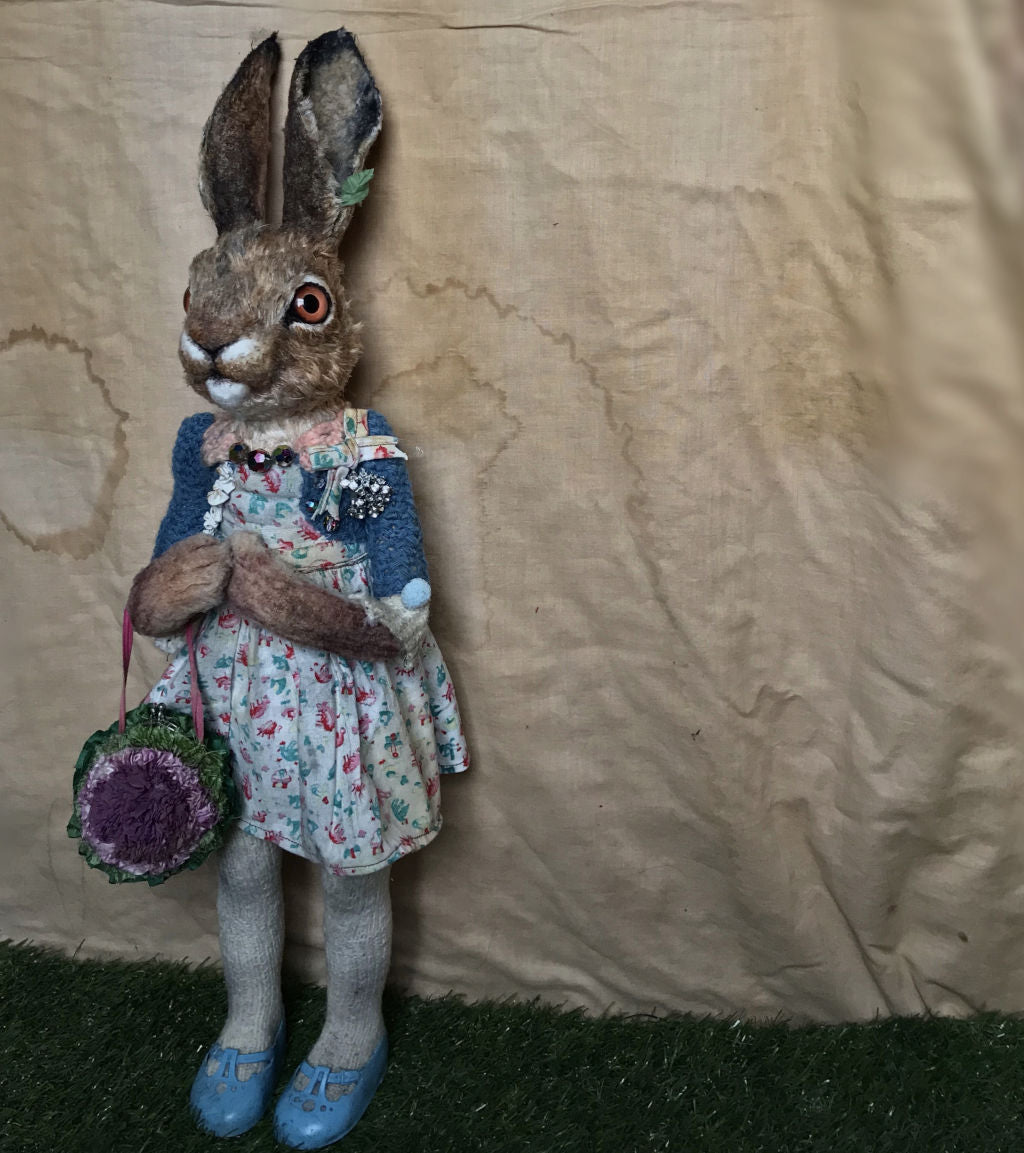 Furn - Textiles and mixed media for Annie Montgomerie's solo show, Railing Latchers, at Beinart Gallery in 2021.
Furn - Textiles and mixed media for Annie Montgomerie's solo show, Railing Latchers, at Beinart Gallery in 2021.
IRS: You originally studied stone carving before moving on to art and design, and you say that this time studying gave you the foundations that you built on to create your sculptures, but that a lot of the techniques you use were self taught. Looking back through your work it looks like you’ve used a range of different techniques and approaches over time before getting to where you are now. Could you give some insight into this learning process and the evolution of your work?
AM: Studying stone carving gave me the skills for making 3D objects, and Art and Design showed me the importance of transporting what’s in your head into your art. When I first started I used to sew all my pieces but wanted them to be more detailed so I experimented with using thin fabric like papier-mâché over a sculpture. My techniques are all part experimental, part happy accidents. I just bash away at ideas until I find something that works. I realised that shredding silk or other thin fabric could be applied to look more realistic than faux fur, it’s quite time consuming and laborious but I apply the “fur” in thin strips from the base up to the nose. Obviously time and practice has made my pieces evolve, when I sculpt a piece it does get easier and hopefully better every time. There are still some animals that I just can’t seem to get the hang of and end up squishing it up.
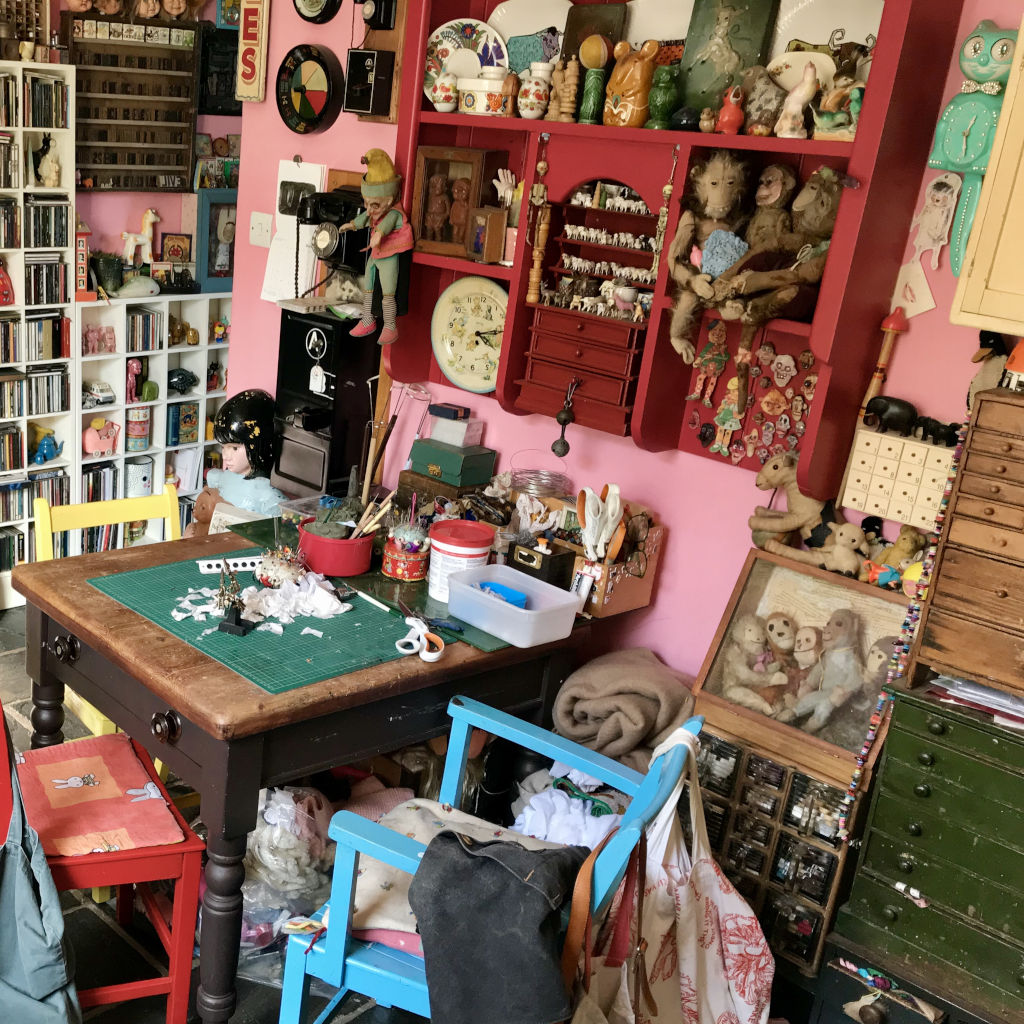
Annie Montgomerie's workspace.
IRS: Could you take us through the process of creating one of your sculptures?
AM: I start by sculpting a piece, I then cut muslin up into pieces and layer it on with a mix of fabric and pva glue, usually around 4 to 5 layers and leave it to dry completely. I cut the piece open and hollow the clay out, put the head back together and apply the fur. I paint and stain the features and then attach the body, I usually make the arms and hands/paws/hooves and attach them at the same time. I then get out my huge bags of fabric and wool treasures to find and make the outfits.
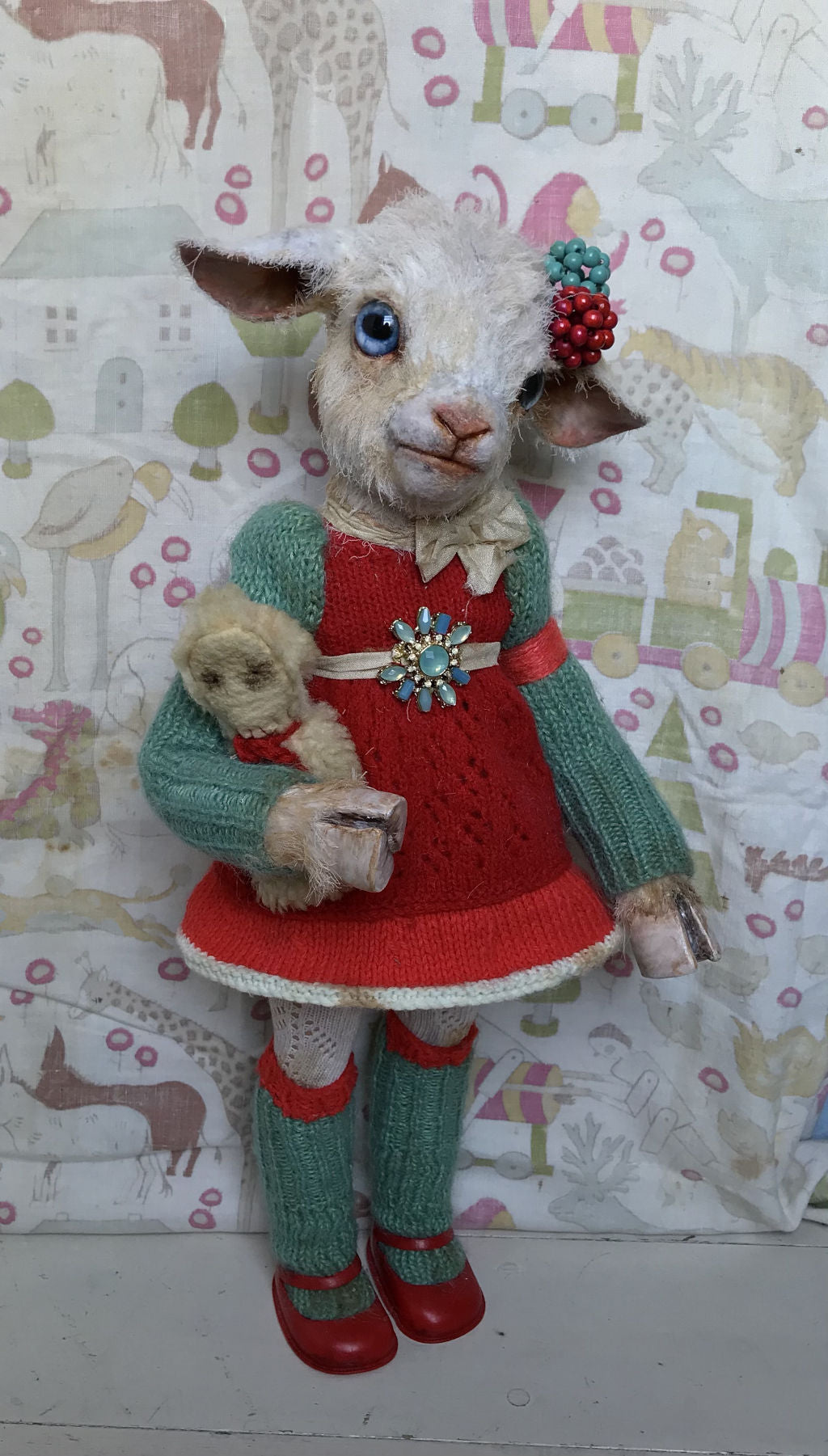
Bliddy Kiddy Girly - Textiles and mixed media for Annie Montgomerie's solo show, Railing Latchers, at Beinart Gallery in 2021.
IRS: I know that a lot of the outfits and embellishments for your figures are old/vintage pieces you’ve foraged from charity and second hand shops. To what extent are the characters inspired by the pieces you dress them in and vice versa?
AM: Funny question to answer, what came first: the chicken or the egg? The answer is either, sometimes I see something at a flea market etc and think of a character wearing or holding that thing, other times I make a character and then go rummaging in my stash for something suitable. All my work has a vintage feel about it, and it just goes hand in hand with my favourite pastime of vintage shopping.

Worter - Textiles, epoxy clay, plastic, wool, vintage and other findings for Annie Montgomerie's solo show, Fitting In, at Beinart Gallery in 2022.
IRS: Each of your sculptures seems to have its own personality, and there is a tender vulnerability to these childish little beings that many people are drawn to. As an artist you put so much time into making these figures which seem so sentimental, is it often a struggle to let them go?
AM: I do struggle to let some of them go, I have them in my house on display for a month or so until I’ve created a collection. The places where they sit look empty when they go but I soon create another to sit in that place.
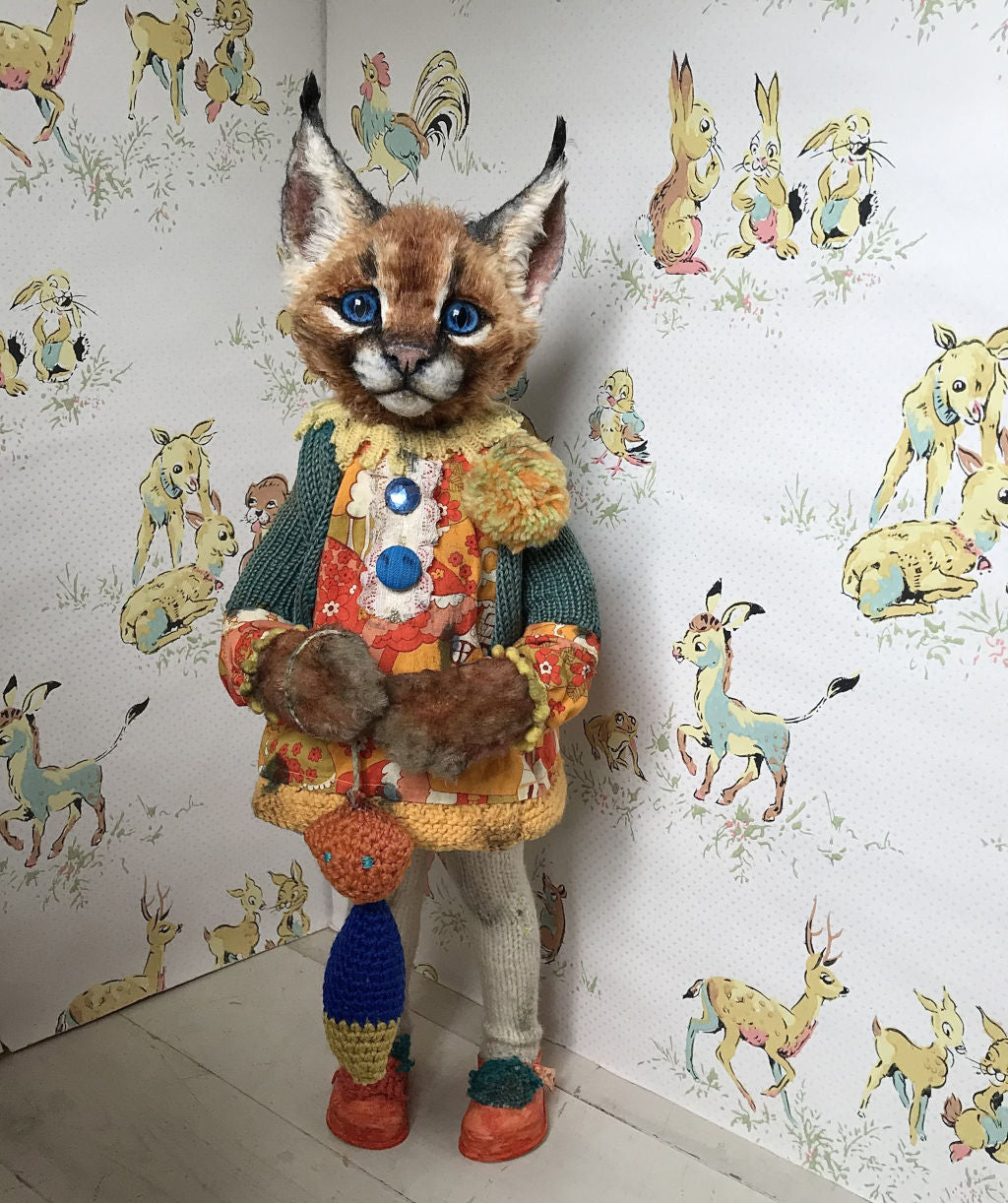
Mord - Textiles and mixed media for Annie Montgomerie's solo show, Railing Latchers, at Beinart Gallery in 2021.
IRS: You recently published your first book about your work - “The Art of Annie Montgomerie: Flocked and Socked”. How did you find the process of writing and publishing a book? Was it something you’ve always wanted to do?
AM: I had thought about having my own book but sort of put it on the back burner as I didn’t have a clue how to go about it, then along came Long Gone John (John Mermis). He has his own record label and vinyl toy company and also produces artist’s books. John and his editor Mark Cox created a beautiful book from images and words I emailed across. It was a privilege to work with them and I’m thrilled with the book.
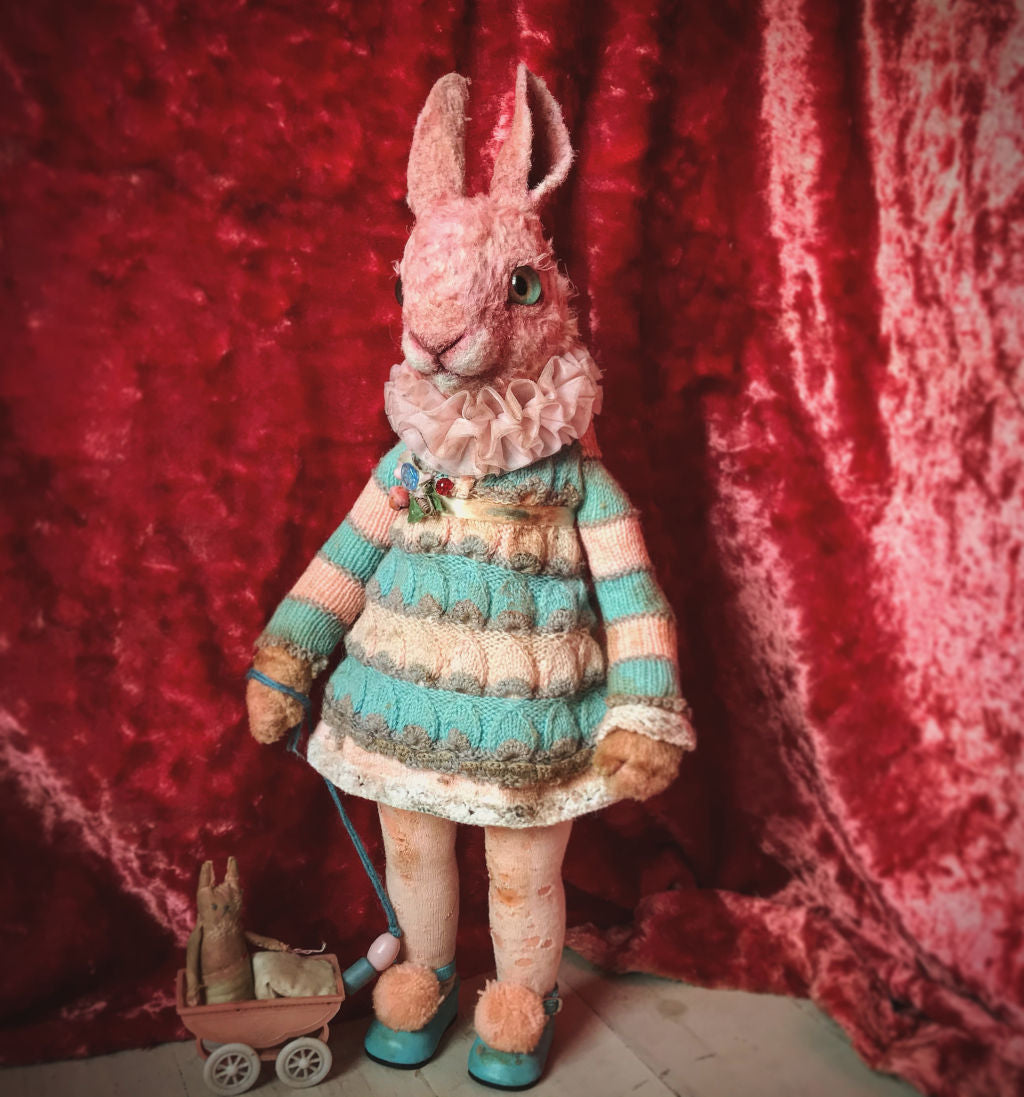
Carni - Textiles and mixed media for Annie Montgomerie's solo show, Railing Latchers, at Beinart Gallery in 2021.
IRS: You have an upcoming show at Beinart Gallery, can you tell us a bit about the themes and the pieces you’ve created for this show?
AM: The theme of my little show is ‘Fitting In’. Harking back to my childhood as all my pieces do, the collection is about the loners in the class, misfits that form friendships. No matter how inadequate you feel there are like minded beings to connect with.

Pieces for Annie Montgomerie's solo show, Fitting In, at Beinart Gallery in 2022.
This interview was written by Indigo Rawson-Smith for Beinart Gallery in July 2022.
Indigo Rawson-Smith wears many hats, most notably as a Gallery Manager at Beinart Gallery, Jeweller for her brand Indigo Nox Jewellery, and as a devoted mother to her giant puppy Sappho.
Having spent a few years working in galleries and art spaces around London she relocated to Melbourne to undertake full-time study in jewellery design, becoming a member of the Beinart Gallery crew in early 2021.
As we’re acquainting ourselves with the concept of social interaction in a post-COVID world, Indigo has been attempting to polish up her rusty social skills while interviewing a number of Beinart Gallery’s exhibiting artists.




 Cart
Cart


